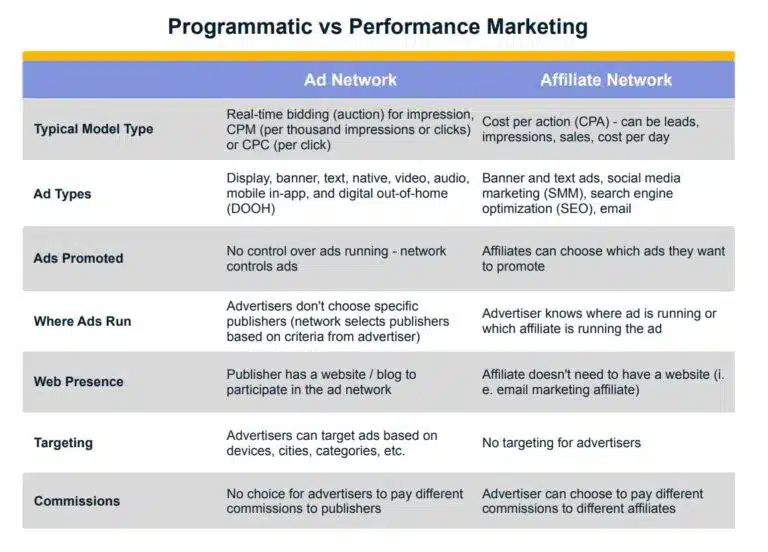Table of Contents
- What is Programmatic Marketing?
- Types of Programmatic Advertising
- Benefits of Programmatic Marketing
- How to Implement a Programmatic Marketing Strategy
- Programmatic vs Performance Marketing
- Programmatic and Performance Marketing Ad Tech Platforms
- Mass Payout Systems Provide Solutions
- Final Thoughts
Artificial intelligence (AI), automated machine learning (ML), and cloud-based services have changed how we do business and interact. Businesses use software platforms with these technological advances to efficiently market their products to people.
Programmatic marketing is used for automated ad placement through digital advertising platforms. For marketing and product movement, programmatic advertising has added proverbial fuel to the digital ad space fire.
This article defines and explains programmatic advertising and compares it to performance marketing. Then it goes a step further by letting you know how automated mass payments work in the programmatic marketing space.
What is Programmatic Marketing?
Programmatic marketing is precision-targeted automated online advertising purchasing (and selling) and ad campaign tracking through an AI-driven ad network software platform. Programmatic marketing (a.k.a. programmatic advertising) connects demand from advertisers and context-driven ad supply for specified buyer categories.
Ad networks offer real-time bidding (RTB) for impressions using auctions or fixed pricing for a cost per click (CPC) or per thousand impressions (CPM).
Ad tech platforms began using machine learning algorithms to connect advertisers with publishers instantly. System considerations include context, digital behavior, and targeted buyer types.
The 4 main components of integrated programmatic marketing platforms are:
- Publishers selling digital advertising on a supply-side platform (SSP)
- Advertisers using a demand-side platform (DSP)
- Data management platform (DMP) for data and analysis
- Ad exchange connects the systems for automated digital advertising buying and selling and tracking ad campaign results.
Programmatic marketing streamlines the process of placing ads with publishers, making it easier than ever to place ads on millions of blogs, online magazines, and mobile device apps. These publishers sell their valuable ad space to advertisers in milliseconds through various ad networks, such as Google AdSense and Revcontent (for native ads).
Programmatic display marketing is a subset of programmatic marketing.
What is Programmatic Display Marketing?
Programmatic display marketing is automatic targeted online display advertising buying through an AI-driven ad network linking the advertiser buyer and publisher seller that’s tied to the digital behavior of a potential buyer.
Types of Programmatic Advertising
Programmatic marketing ads include display advertising, native ads, video ads (including YouTube), audio ads, mobile in-app ads, and digital out-of-home (DOOH) ads.
In the advertising space, native ads are ad messages made to look like another part of informative content rather than advertising.
Digital out-of-home ads include content on digital screens, elevators, and digital billboards.
Here’s an example of programmatic marketing using a digital out-of-home advertising technique for increasing sales. Walgreens Boots Alliance implemented a store rollout of the Cooler Screens programmatic ad network with sensor data and digital screens streaming content. After the content plays, it automatically opens refrigerator or freezer cases for buyers (replacing manual doors).
Benefits of Programmatic Marketing
Programmatic marketing benefits for advertisers are time savings and marketing continuity achieved through implementing a targeted automatic online ad buying campaign within an ad spend budget. Programmatic marketing may increase conversions and digital advertising ROI.
AI-driven ad network platforms include ad performance and results tracking for advertisers and publishers selling the ads. Besides making sales, programmatic media buying builds brand awareness.
The benefits of programmatic advertising for publishers include selling more online ads through ad networks and reducing required ad sales staff. And ad networks benefit by earning a percentage of ad sales transactions in programmatic marketing.
How to Implement a Programmatic Marketing Strategy
7 steps to implement a programmatic marketing strategy as the advertiser are:
- Establish strategic goals for programmatic marketing.
- Determine the type of programmatic ad campaign.
- Define the location, browser type, and other buyer persona categories to target.
- Research demand-side platforms (DSPs) for best fit and choose a DSP.
- Set a programmatic advertising budget and provide a deposit to the DSP.
- Set programmatic campaign dates, limits for frequency, and maximum impressions in the software.
- Review real-time reports on programmatic advertising campaign results and take retargeting actions.
Programmatic vs Performance Marketing
Programmatic vs performance marketing is the difference between paying for impressions or results in digital marketing.
Programmatic marketing is real-time bidding for targeted digital ad impressions, which don’t necessarily result in any action taken by or lead from a potential buyer.
Performance marketing is paying for results like ad clicks, lead generation through form completion, or other actions. Performance marketing also includes payments for affiliate marketing referrals that result in sales.
Power your entire partner payouts operations
98%
Customer Satisfaction
$60B+
Annual Transactions
4M+
Partners
4,000+
Customers
99%
Customer Retention
Programmatic and Performance Marketing Ad Tech Platforms
Several different types of platforms are used for programmatic advertising and marketing campaigns. With a few key differences, they function in similar ways.
Programmatic ad tech platforms (ad exchanges) automate the process of connecting advertisers with publishers’ ad inventory for media buying and can help you track results, including conversions and ROI.
The primary ad tech platforms that most advertisers and publishers work with are ad networks and affiliate networks.

Affiliate Networks
Affiliate networks are great for websites and bloggers who have a dedicated audience. The authors of these sites can earn a commission from each sale made through the links that they provide.
Amazon Associates is perhaps the most recognizable affiliate network that makes the process of affiliate marketing easier than ever.
The ad types are diverse, ranging from banner and text ads, social media marketing, search engine optimization (SEO) for web pages, and email marketing. The affiliates get to choose which ads they want to promote, where they want to promote them, and when they want to place the ads.
This process gives both the affiliates and the advertisers tremendous control. They know where the ad is running and on which websites.
In affiliate network marketing, there is no direct audience targeting by the advertisers. Affiliates can choose to place ads without first being approved by the advertisers. Advertisers sit back and let the affiliates do all of the heavy lifting.
Affiliates choose the ads, place them, and commit their efforts to make sales on behalf of the advertisers.
Advertisers pay commissions based on various metrics, such as leads, impressions, or sales. The commission varies greatly, depending on the advertising brand and what kind of audience the affiliate offers.
Ad Networks
Ad networks, like affiliate networks, measure impressions and clicks to determine payments.
Ads are automatically placed on publisher sites, as determined by the algorithm of the ad network.
Though advertisers cannot hand-pick the publishers they are working with, they can specify their target audience before releasing their ads to the networks. The target audience is often determined by the demographics of online users, such as location, education level, gender, age, and online behavior.
There is little flexibility in paying the publishers. Everything is automated by the ad tech platforms from which they connect with publishers. Even so, the ad tech platforms must find a way to collect and distribute payments in a timely and legal manner.
While many have done their best, a culture of late payments and corruption has developed within the industry, getting in the way of the massive potential that programmatic advertising has to offer.
Main Pain Points of Ad Tech Systems
As revolutionary as many ad tech platforms are, they are riddled with problems that often prevent publishers and advertisers alike from achieving their goals.
The onboarding process for gathering partners relies heavily on single data entry of partner profiles, including sensitive payment information and tax documentation. From there, transactions are manually input into banking portals and checked by humans before payments can be processed.
As you can imagine, this makes the entire system highly error-prone with very little data validation.
As brands and companies begin to grow, leading to more digital ads and traffic, payments grow along with it. This rapid growth often outpaces the ad tech companies and their ability to process payments efficiently and securely.
It also hinders transparency in payments and allows more room for ad fraud, such as bots designed to simulate fake clicks and impressions of the ads, to slip through the cracks more easily.
As a result, advertisers begin paying massive sums of money for ads they’re not sure are effectively being placed, and publishers are left nervously awaiting their next payments. And every business owner knows the importance of not spending money where it’s not warranted.
Mass Payout Systems Provide Solutions
With the advent of technology over the past several decades, users have become accustomed to receiving information, products, services, and payments with the single push of a button. Naturally, advertisers and publishers expect immediate payment solutions and information about payments, as well.
As technology has made advertising and marketing faster and easier than ever before, it has also sprouted payment solutions within the advertising industry.
While speed and ease are certain qualities businesses are looking for in their payment solutions, there are far more benefits to a modern payment infrastructure than ‘fast’ payments.
Modern payment platforms increase the speed at which payments can be distributed. They also eliminate a lot of the workload and errors from traditional human-led payment solutions.
A global payables operation, such as the cloud solution provided by Tipalti, improves the overall partner payment experience in many ways. Including, of course, how quickly payments are made.
Mass payments allow advertisers and ad tech systems to validate payments immediately and significantly reduce common human errors in rapidly growing e-commerce and advertising systems. Human errors are reduced considerably. And much of the payables workload that comes with it is reduced by up to 80 percent.
This frees up both time and money for advertisers, publishers, and ad tech companies to further grow their businesses and increase cash flow.
The real-time data collected allows advertisers and publishers to quickly determine if their partnerships provide the greatest ROI or if new ones should be made instead. It also offers clean and easy tax compliance, often a nightmarish battle for fast-growing businesses and websites.
And as businesses continue to grow, the automated mass payout solutions can grow with them.
Automated global payables operations are trustworthy, making attracting and retaining partners more effortless than ever. The easier it is to attract and retain partners, the more your business can grow.
Final Thoughts
Businesses and advertisers look for safe and efficient ways to market their products and services. Programmatic ad buying of digital media is a solution. Companies can now find ad tech systems (programmatic marketing) using secure mass payout automation systems.
As technology advances and businesses grow, these automated payment solutions will advance and grow with them. With programmatic technology, companies operate efficiently, and the software does the advertising.

